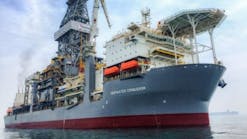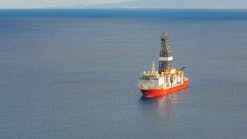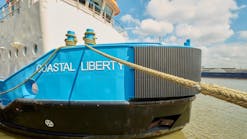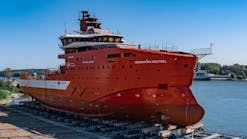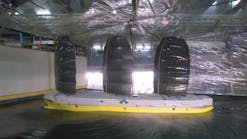Bruce Beaubouef • Houston
Offshore service vessels (OSV) are becoming larger, more specialized, and more technically sophisticated as a result of the rising demand for more complex deepwater field developments, including those in the Gulf of Mexico, according to a recent study by Germanischer Lloyd.
The study further noted that there are about 2,500 OSVs worldwide and that the number is projected to rise from now through 2020. In addition to upstream oil and gas demand, the call for OSVs will grow to meet the offshore wind industry plans.
All this has led to an expanded definition of OSV which now refers to “not only traditional supply boats, but also anchor handling tug/supply ships, well stimulation ships, and standby ships” and even those “built to carry hazardous and noxious substances, to fight fires, or to occasionally recover oil,” said Stephen Gumpel, area manager North and Central America at Germanischer Lloyd.
VB-10,000 completes heavy lift assignment in Gulf
Versabar Inc. says that theVB-10,000, its new catamaran heavy-lift vessel, has successfully completed its first heavy lift operation in the Gulf of Mexico. On Oct. 7, tugs towed the VB-10,000 through Aransas Pass, Texas, and into the Gulf of Mexico. Just over 48 hours later, on Oct. 9, the vessel used its hook-height systems to bring up a 1,530-ton topside. Consisting of twin 240-ft (73-m) tall gantries mounted on custom-built barges, the vessel lifts with four independent blocks that can be controlled either separately or in synchronization.
Versabar says this rapid deployment testifies to the high level of engineering that went into the building of the new lift system, and builds on its proven offshore lift designs, including the Versatruss and the Bottom Feeder concepts (see related story on p. 68).
Dockwise to build new “super vessel”
Dockwise Ltd. says its board of directors has approved the commissioning of a newbuild vessel to serve the emerging demand for ocean transports of up to and above 100,000 metric tons (110,213 tons). The decision is subject to approval by a special general meeting of shareholders to authorize the proposed $100-million rights issue to part-finance the investment.
Dockwise Ltd. says it will move forward with plans for a newbuild vessel to serve the emerging demand for ocean transports of up to and above 100,000 metric tons (110,213 tons).
As announced in August, Dockwise has been studying the feasibility of investing in a new semisubmersible monohull vessel, bigger than its current largest vessel, theBlue Marlin. This so-called “Type 0” vessel will have a deck size of 275 x 70 m (902 x 229 ft), a first for the maritime transport industry, and is expected to require a total investment of approximately $200 million. Dockwise has applied for a patent on the design of the vessel.
Dockwise says that the majority of its revenues originate from the oil and gas industry, and current trends for projects and equipment in this market are distinctly moving towards greater scale and size for premier projects:
- Exploration and production is shifting from shallow water in traditional areas to deepwater and remote areas
- Industry demand is for larger, heavier equipment, in single transportable modules
- Plant and equipment is increasingly constructed in dedicated, low cost environments ahead of transportation.
With the company’s existing backlog in combination with projects on the horizon, it is expected that the vessel will be occupied when it will come out of the shipyard in the latter part of 2012. Dockwise is in the process of negotiating with selected first-rate shipyards for construction of the new vessel.
Arctech to build icebreaker supply vessels
Arctech Helsinki Shipyard Oy has an order from Sovcomflot for two newbuild icebreaking supply vessels. The $200-million contract calls for delivery of both vessels during spring 2013.
Arctech Helsinki Shipyard Oy will build the new vessels for Sakhalin-1 Arkutun-Dagi gas field where they will supply the Exxon Neftegas platform. Both vessels will be similar measuring 99.2 m (325 ft) in length and 21.7 m (71 ft) in breadth. Their four engines have the total power of 18,000 kW and the propulsion power of 13,000 kW.
As multipurpose vessels, these will be able to carry various type of cargo and they are equipped for oil combating, fire fighting, and rescue operations. Both vessels will be able to operate in 1.7 m (5.6 ft) of ice and temperatures to -35º C.
Arctech is a joint venture of STX Finland and Russia’s state-owned United Shipbuilding Corp.
Pride orders new drillship
Pride International Inc. has contracted Samsung Heavy Industries Ltd. to build a fifth ultra-deepwater drillship for $600 million. The vessel will be built in Geoje, South Korea, with a mid-2013 delivery target.
The new drillship, to be named at a later date, is based on an SHI proprietary hull design measuring 750 ft (229 m) long and 140 ft (43 m) wide. The rig is designed for drilling in water depths of up to 12,000 ft (3,658 m), with a total vertical drilling depth of 40,000 ft (12,192 m), and will offer a pay load in excess of 20,000 metric tons (22,046 tons) and a 1,250-ton hoisting system.
The rig will be equipped with dynamic positioning in compliance with DPS-3 certification, six 5.5 MW thrusters, expanded drilling fluids capacity, a 15,000 psi subsea well control system and upgraded system handling, and living quarters for up to 200 personnel.
Offshore Articles Archives
View Oil and Gas Articles on PennEnergy.com



